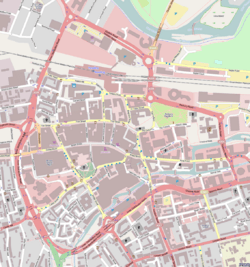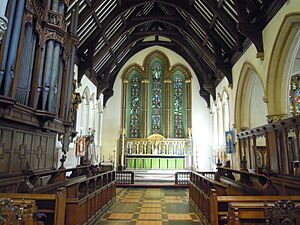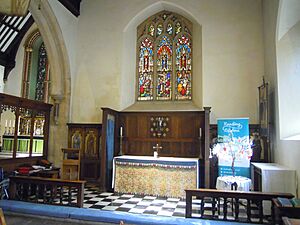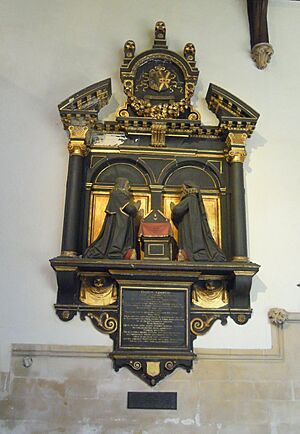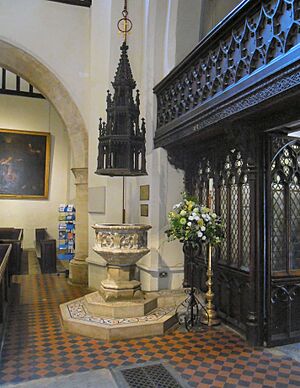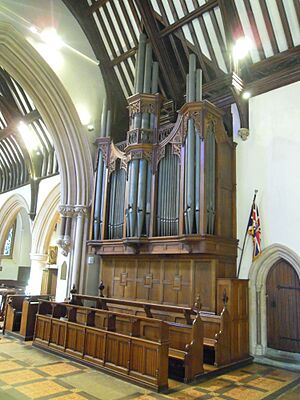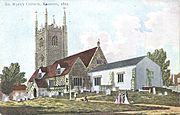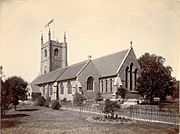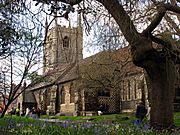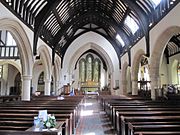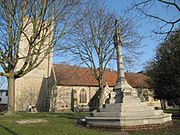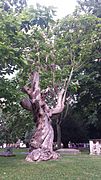Reading Minster facts for kids
Quick facts for kids Reading Minster |
|
|---|---|
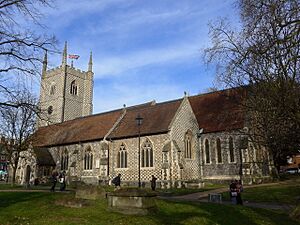
The church tower, decorated with a checkerboard pattern of flint and stone.
|
|
| 51°27′16.2″N 0°58′25.0″W / 51.454500°N 0.973611°W | |
| Location | Reading |
| Country | England |
| Denomination | Church of England |
| Previous denomination | Roman Catholic |
| Website | readingminster.org.uk |
| History | |
| Founded | 7th century |
| Dedication | St Mary |
| Architecture | |
| Functional status | Active |
| Heritage designation | Grade I |
| Style | Gothic |
| Administration | |
| Archdeaconry | Berkshire |
| Diocese | Oxford |
Reading Minster, also known as the Minster Church of St Mary the Virgin, is the oldest church in the town of Reading, England. For a long time, the nearby Reading Abbey was more famous. But after the Abbey was destroyed, Reading Minster became important again. Today, it is an active Anglican parish church.
The church is located on a street named St Mary's Butts, which gets its name from the Minster. It's easy to mix it up with another church, St Mary's Church on Castle Street, which is very close by.
Contents
A History Through Centuries
Reading Minster has a very long and fascinating history that stretches back over a thousand years.
Early Beginnings
According to legend, a saint named Saint Birinus built a small chapel here in the 7th century. In the 9th century, silver coins were found in the churchyard. These coins are from the time when kings like Ethelred and Alfred were fighting Danish Vikings in Reading.
In 979, Queen Ælfthryth, the wife of King Edgar, built a nunnery on this site. A nunnery is a place where religious women called nuns live. The only part of the nunnery that still exists is a rounded Saxon-style door inside the church. Sadly, in the 11th century, Danish Vikings attacked Reading and destroyed the nunnery.
The Age of Reading Abbey
In 1121, King Henry I started a huge new project: Reading Abbey. The Abbey became one of the most powerful religious places in England. For the next 400 years, the head of the Abbey was also in charge of St Mary's Church.
Rebuilding the Church
In 1539, a major change happened in England. King Henry VIII decided to close down all the abbeys and monasteries, including Reading Abbey. This was part of a period called the Reformation.
St Mary's Church was also affected. Its statues and stained-glass windows were removed. By 1550, the church was in bad shape and needed big repairs. Between 1551 and 1555, the townspeople rebuilt the church. They cleverly used stone and wood from the ruins of the giant Abbey next door. It's believed that the tall stone pillars you can see inside the church today were taken directly from the Abbey.
Later Additions and Changes
Over the years, more features were added to the church.
- The baptismal font, where babies are christened, was added in 1616. It is decorated with carved shields.
- A large black-and-gold monument to a wealthy local man named William Kendricke was put up in 1635. He gave a lot of money to help the church.
- In 1918, a special chapel was added to remember soldiers who died in war. It is called St. Edward's Chapel.
The church has been restored several times to keep it in good condition, with major work done in the 1800s and more recently between 1997 and 2003.
The Church Bells and Organ
Most of the bells in the church tower are very old. Some date back to the 1640s and 1740s. The first clock was put in the tower way back in 1611.
The church's organ is also special. It was built by a famous organ maker named Father Willis for the Great London Exposition of 1862, a huge international fair. Over time, the organ became worn out. A project was started to raise money to restore this historic instrument and make it sound beautiful again.
The Churchyard
The church is surrounded by a churchyard with paths and large trees. One of the most famous trees is an Indian Bean Tree (Catalpa bignonioides) that is over 150 years old.
In the churchyard, you can also see the Jubilee Cross. It was built in 1887 to celebrate 50 years of Queen Victoria's reign, known as her Golden Jubilee. The cross is carved from stone in an old-fashioned style and is a protected historic landmark.
Gallery


